Oxford University Press's Blog, page 757
October 1, 2014
Can Cameron capture women’s votes?
After the Scottish Independence Referendum, the journalist Cathy Newman wrote of the irony that Cameron – the man with the much reported ‘problem’ with women – in part owes his job to the female electorate in Scotland. As John Curtice’s post-referendum analysis points out, women seemed more reluctant than men to vote ‘yes’ due to relatively greater pessimism of the economic consequences of a yes vote.
The Scottish vote should remind Cameron and the Conservative strategists who advise him of a very clear message: ignore women voters at your peril.
For several decades after UK women won the right to vote, Conservatives could rely on women’s votes and the gender gap in voting was consistently in double figures. However in recent decades this gap has diminished, particularly amongst younger women and party competition to mobilize female voters has become more important. Of course women voters have many diverse interests but understanding the concerns of different groups of women voters is crucial as female voters often make their decisions on voting closer to the election.
So what does Cameron need to do to firmly secure women’s votes at the general election? We argue the Conservative Party needs to make sure it represents women descriptively, substantively, and symbolically. On all three counts we see problems with Cameron’s strategy to win women’s votes.
Pre-election rhetoric and pledges to feminise the party through women’s descriptive representation have not been matched with clear and tangible outcomes. Cameron tried to increase the number of women MPs but still the share of women in the Conservative Party in the House of Commons is just 16%. As the latest Sex and Power Report highlights this looks unlikely to increase significantly in GE2015 as so few women have been selected to stand in safe Conservative seats despite the campaigning and support work undertaken by Women2Win.
 Prime Minister David Cameron talks about the future of the United Kingdom following the Scottish Referendum result. Photographer: Arron Hoare. Photo: Crown copyright via Number 10 Flickr.
Prime Minister David Cameron talks about the future of the United Kingdom following the Scottish Referendum result. Photographer: Arron Hoare. Photo: Crown copyright via Number 10 Flickr.Even where Cameron has strong power and autonomy to improve women’s presence – by fulfilling his pledge that one-third of his government would be women by the end of parliament – he has managed just 22%. Last July’s reshuffle did not erase the impression that women are not included at Cameron’s top table.
Without enough women representatives in Parliament and in Government to advise on policy proposals in development, there have been many problematic policy initiatives, such as the disastrous proposal to raise child care ratios. The Government’s approach to addressing public debt through austerity has been detrimental to women by reducing incomes, public services, and jobs, the effects of which even female Conservative supporters are more likely to express concerns about.
Cameron’s Conservatives in government also do not have the institutional capacity to get policies right for women. There are still not enough women in strategically significant places. For example in the Coalition Quad of Cameron, Osborne, Clegg, and Alexander control policy making. The gender equality machinery set up by the last government to monitor and address gender inequality in a strategic and long-term way has been stripped out. Even at the emergency post-referendum meeting at Chequers to discuss the UK’s constitutional future there was just one woman at the table.
Although the gender gap in voting, which currently favours Labour, is likely to narrow as the election approaches, the Conservatives have, we argue, inflicted significant psephological damage on themselves in their strategies to attract women’s votes: by not promoting women into politics, by not protecting women from austerity, and by stripping out the governmental institutions which give voice to women and promote gender equality.
Cameron’s political face may have been saved by Scottish women last month but for the reasons outlined in this blog post, we suggest that in the critical contestation for women’s votes at the 2015 general election there are long standing weaknesses in the Conservative Party’s strategy for mobilising women’s votes and restoring the Party’s historical dominance among women voters.
The post Can Cameron capture women’s votes? appeared first on OUPblog.









 Related StoriesWho decides ISIS is a terrorist group?The pros and cons of research preregistrationCinematic tragedies for the intractable issues of our times
Related StoriesWho decides ISIS is a terrorist group?The pros and cons of research preregistrationCinematic tragedies for the intractable issues of our times
On the importance of independent, objective policy analysis
I have written about the dangers of making economic policy on the basis of ideology rather than cold, hard economic analysis. Ideologically-based economic policy has laid the groundwork for many of the worst economic disasters of the last 200 years.
The decision to abandon the first and second central banks in the United States in the early 19th century led to chronic financial instability for much of the next three quarters of a century.
Britain’s re-establishment of the gold standard in 1925, which encouraged other countries to do likewise, contributed to the spread and intensification of the Great Depression.
Europe’s decision to adopt the euro, despite the fact that economic theory and history suggested that it was a mistake, contributed to the European sovereign debt crisis.
President George W. Bush’s decision to cut taxes three times during his first term while embarking on substantial spending connected to the wars in Afghanistan and Iraq, was an important driver of the macroeconomic boom-bust cycle that led to the subprime crisis.
In each of these four cases, a policy was adopted for primarily ideological, rather than economic reasons. In each case, prominent thinkers and policy makers argued forcefully against adoption, but were ignored. In each case, the consequences of the policy were severe.
So how do we avoid excessively ideological economic policy?
One way is by making sure that policy-makers are exposed to a wide range of opinions during their deliberations. This method has been taken on board by a number central banks, where many important officials are either foreign-born or have considerable policy experience outside of their home institution and/or country. Mark Carney, a Canadian who formerly ran that that country’s central bank, is not the first non-British governor of the Bank of England in its 320-year history. Stanley Fischer, who was born in southern Africa and has been governor of the Bank of Israel, is now the vice chairman of the US Federal Reserve. The widely respected governor of the Central Bank of Ireland, Patrick Honohan, spent nearly a decade at the World Bank in Washington, DC. One of Honohan’s deputies is a Swede with experience at the Hong Kong Monetary Authority; the other is a Frenchman.
 Money cut in pieces, by Tax Credits (TaxCredits.net). CC-BY-2.0 via Flickr.
Money cut in pieces, by Tax Credits (TaxCredits.net). CC-BY-2.0 via Flickr.But isn’t it unreasonable to expect politicians to come to the policy making process without any ideological bent whatsoever? After all, don’t citizens deserve to see a grand contest of ideas between those who propose higher taxes and greater public spending with those who argue for less of both?
In fact, we do expect—and want–our politicians to come to the table with differing views. Nonetheless, politicians often support their arguments with unfounded assertions that their policies will lead to widespread prosperity, while those of their adversaries will lead to doom. The public needs to be able to subject those competing claims to cold, hard economic analysis.
Fortunately, the United States and a growing number of other countries have established institutions that are mandated to provide high quality, professional, non-partisan economic analysis. Typically, these institutions are tasked with forecasting the budgetary effects of legislation, making it difficult for one side or the other to tout the economic benefits of their favorite policies without subjecting them to a reality check by a disinterested party.
In the United States, this job is undertaken by the Congressional Budget Office (CBO) which offers well-regarded forecasts of the budgetary effects of legislation under consideration by Congress. [Disclaimer: The current director of the CBO is a graduate school classmate of mine.]
The CBO is not always the most popular agency in Washington. When the CBO calculates that that the cost of a congressman’s pet project is excessive, that congressman can be counted on to take the agency to task in the most public manner possible.
According to the New York Times, the CBO’s “…analyses of the Clinton-era legislation were so unpopular among Democrats that [then-CBO Director Robert Reischauer] was referred to as the ‘skunk at the garden party.’ It has since become a budget office tradition for the new director to be presented with a stuffed toy skunk.”
For the most part, however, congressional leaders from both sides of the aisle hold the CBO and its work in high regard, as do observers of the economic scene from the government, academia, journalism, and the private sector.
The CBO, founded in 1974, is one of the oldest of such agencies, predated only by the Netherlands Bureau for Economic Policy Analysis (1945) and the Danish Economic Council (1962). More recent additions to the growing ranks of these agencies include Australia’s Parliamentary Budget Office (2012), Canada’s Parliamentary Budget Officer (2006), South Korea’s National Assembly Budget Office (2003), and the UK’s Office for Budget Responsibility (2010).
These organizations each have their own institutional history and slightly different responsibilities. For the most part, however, they are constituted to be non-partisan, independent agencies of the legislative branch of government. We should be grateful for their existence.
The post On the importance of independent, objective policy analysis appeared first on OUPblog.









 Related StoriesThe Hunger Games and a dystopian Eurozone economyThe economics of Scottish IndependenceWhat can old Europe learn from new Europe’s transition?
Related StoriesThe Hunger Games and a dystopian Eurozone economyThe economics of Scottish IndependenceWhat can old Europe learn from new Europe’s transition?
September 30, 2014
Setting the scene of New Orleans during Reconstruction
The Reconstruction era was a critical moment in the history of American race relations. Though Abraham Lincoln’s Emancipation Proclamation made great strides towards equality, the aftermath was a not-quited newly integrated society, greatly conflicted and rife with racial tension. At the height of Radical Reconstruction, in June 1870, seventeen-month-old Irish-American Mollie Digby was kidnapped from her home in New Orleans — allegedly by two Afro-Creole women. In The Great New Orleans Kidnapping Case: Race, Law, and Justice in the Reconstruction Era, Michael A. Ross offers the first ever full account of this historic event and subsequent investigation that electrified the South. The following images set the scene of New Orleans during this time period of racial amalgamation, social friction, and tremendous unease.
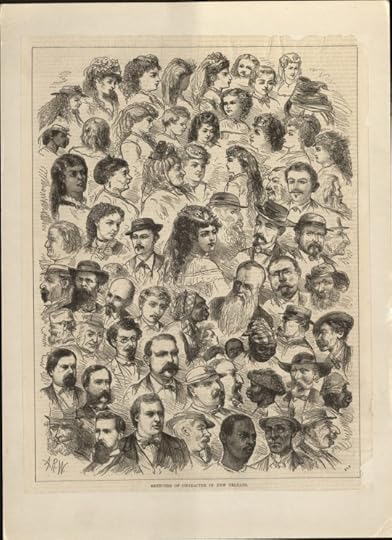
The Diverse New Orleans Population
A depiction of the diverse population of New Orleans. (Louisiana Image File, LaRC, Tulane University.)
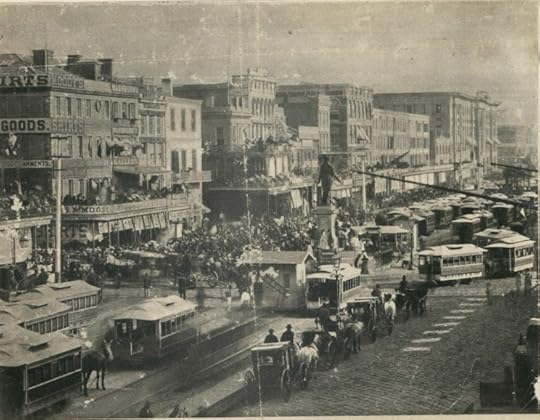
Canal Street
Canal Street in New Orleans during Reconstruction. (Louisiana Image File, LaRC, Tulane University.)
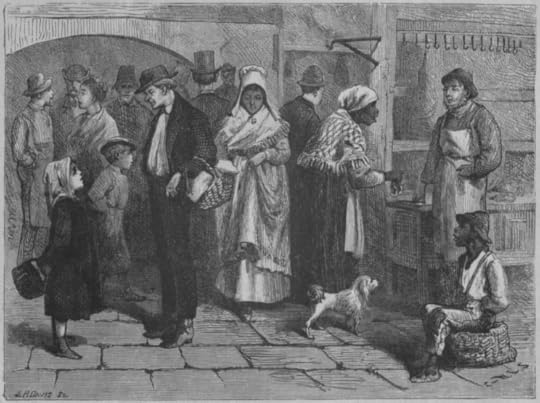
Diversity in the Marketplace
Citizens of all classes frequented the public markets. (Louisiana Image File, LaRC, Tulane University.)
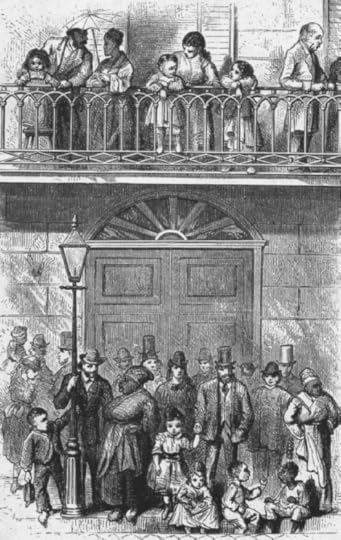
Mardi Gras
A crowd waiting for a Mardi Gras parade. From Edward King, The Great South: A Record of Journeys in Louisiana, Texas, The Indian Territory, Missouri, Arkansas, Mississippi, Alabama, Georgia, Florida, South Carolina, North Carolina, Kentucky, Tennessee, Virginia, West Virginia, and Maryland. (Hartford: American Publishing Company, 1875, pg. 42.)
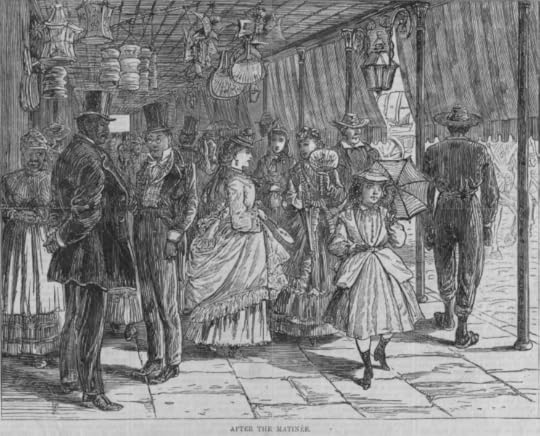
Matinee
Creoles Strolling After a Matinee. (Louisiana Image File, LaRC, Tulane University.)
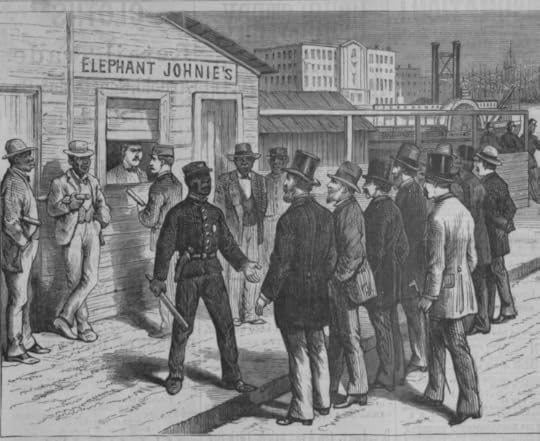
Policing the Streets
A Black Police Officer Addressing a Crowd. (Louisiana Image File, LaRC, Tulane University.)
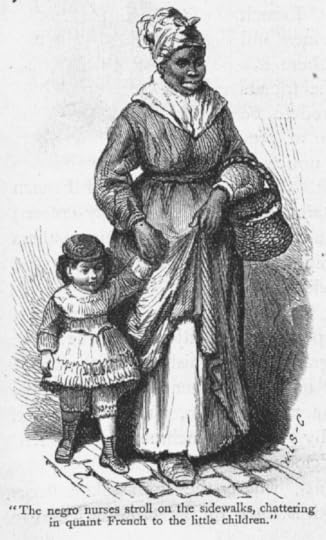
An Afro-Creole Nanny with a White Child
African American nannies escorting white children was a common site in New Orleans. From Edward King, The Great South: A Record of Journeys in Louisiana, Texas, The Indian Territory, Missouri, Arkansas, Mississippi, Alabama, Georgia, Florida, South Carolina, North Carolina, Kentucky, Tennessee, Virginia, West Virginia, and Maryland (Hartford: American Publishing Company, 1875, pg. 30.)
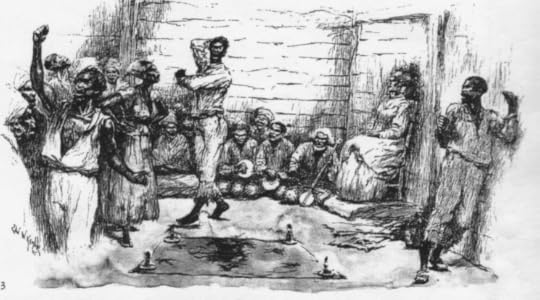
Voodoo Ceremony
Depiction of a Voodoo Ceremony. E.W. Kemble, “Voodoo Dance” from Century Illustrated Monthly Magazine, November 1885 to 1886 (New York: The Century Co., vol. XXXI, New Series, Vol. IX, p.807.)
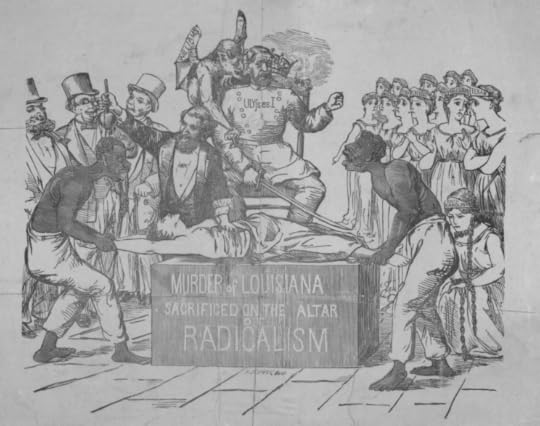
Satirical Cartoon
In this satirical cartoon, Reconstruction in Louisiana under President Grant and the Radical Republicans is depicted as a Greek tragedy. (Louisiana Image File, LaRC, Tulane University.)
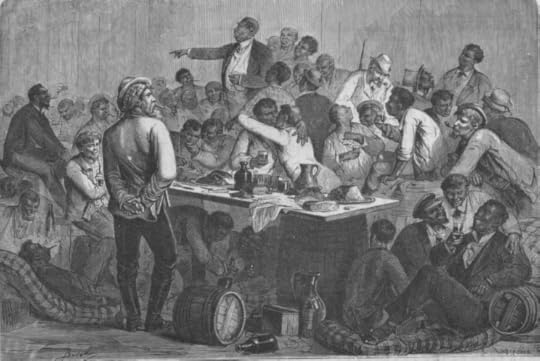
Political Cartoon
Democratic periodicals regularly printed cartoons mocking the biracial Reconstruction legislatures in the South. This cartoon depicts a debauched Louisiana Legislature run by African Americans and poor “scalawag” southern whites. (Louisiana Image File, LaRC, Tulane University.)
Featured image: The City of New Orleans, Louisiana, Harper’s Weekly, May 1862. Public Domain via Wikimedia Commons.
The post Setting the scene of New Orleans during Reconstruction appeared first on OUPblog.









 Related StoriesAustin City Limits through the yearsCelebrating 60 years of CERNWorld War I in the Oxford Dictionary of Quotations
Related StoriesAustin City Limits through the yearsCelebrating 60 years of CERNWorld War I in the Oxford Dictionary of Quotations
Austin City Limits through the years
Austin City Limits is the longest running musical showcase in the history of television, spanning over four decades and showcasing the talents of musicians from Willie Nelson and Ray Charles to Arcade Fire and Eminem. The show is a testament to the evolution of media and popular music and the audience’s relationship to that music, and to the city of Austin, Texas. In Austin City Limits: A History, author Tracey E. W. Laird takes us behind-the-scenes with interviews, anecdotes, and personal photographs to pay homage to this landmark festival. In doing so, she also illuminates the overarching discussion of the US public media and its influence on the broadcasting and funding of music and culture. This year, the festival celebrates its 40th anniversary with guests such as Bonnie Raitt, Jimmie Vaughan, Sheryl Crow, and Alabama Shakes, which will air on PBS on Oct. 3 at 9pm ET.

Unveiling the plaque designating Austin City Limits a music landmark by the Rock and Roll Hall of Fame.
Photo by Tracey E. W. Laird
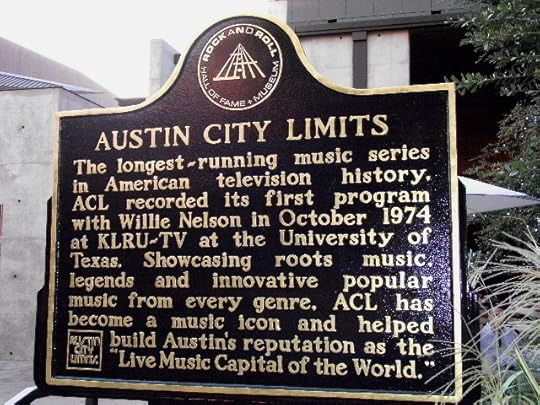
Austin City Limits sign at ACL Live
Moody Theater in Austin, TX. Photo by Ron Baker. CC BY-SA 3.0 via Wikimedia Commons

The entrance gate for the ACL Music Festival.
Shown here in 2009, promises a powerful experience. Photo by Tracey E. W. Laird
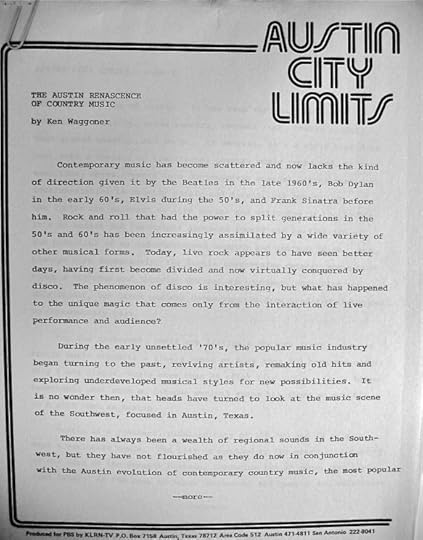
First of 5-page early press release that position Austin City Limits within the “Austin Renascence of Country Music.”
From Radio and Television, Folder 77, Austin City Limits, Southern Folklife Collection, The Wilson Library, University of North Carolina at Chapel Hill. Photo by Tracey E. W. Laird

Willie Nelson performed on the television pilot for Austin City Limits in 1974 when the show was initially celebrating music like country, blues, and rock n’ roll. In 2014, he is still playing shows to tremendous crowds several football fields deep. Here his image is shown projected on the large screens to either side of the stage, at the 2006 ACL Music Festival. Photo by Tracey E. W. Laird
in 1974 when the show was initially celebrating music like country, blues, and rock n’ roll. In 2014, he is still playing shows to tremendous crowds several football fields deep. Here his image is shown projected on the large screens to either side of the stage, at the 2006 ACL Music Festival. Photo by Tracey E. W. Laird

Scott Newton’s famous image of Ray Charles performing in 1984 on Austin City Limits.
Photograph by Scott Newton. Courtesy Austin City Limits/KLRU-TV.

Arcade Fire rehearses in Studio 6A on taping day.
Doug Robb practices shots on the ped cam to the left, Gary Menotti sits at his small round table with a stop watch out front, while Scott Newton studies the scene looking for angles of his own. Over the past decades, the music performed at ACL has evolved to include alternative rock artists like Arcade Fire, to rap and hip-hop artists like Eminem and Mos Def. Photo by Tracey E. W. Laird

In a photo taken during Mos Def’s rehearsal, the paint and lightbulbs screwed into the faux-Austin backdrop look so much different than they do on TV.
Photo by Tracey E. W. Laird

The crowd waits before a double taping for K’Naan and Mos Def in Studio 6A.
Terry Lickona is standing on the bleacher steps to the right in the photo. Photo by Tracey E. W. Laird.

Matisyahu performing at the 2006 ACL Music Festival.
Photo by Tracey E. W. Laird

The audience out front takes in Gillian Welch and David Rawlings along with the new skyline backdrop.
Photo by Tracey E. W. Laird

Scott Newton photographed The Decemberists during their 2007 performance on Austin City Limits.
Photograph by Scott Newton. Courtesy Austin City Limits/KLRU-TV.

That same night, Newton also photographed Ghostland Observatory.
Photograph by Scott Newton. Courtesy Austin City Limits/KLRU-TV.

Longtime camera operator Robert Moorhead
stands before the Austin City Limits signing wall on the 2d floor of station KRLU, a memorial to a long-cherished tradition for staff members and artists. Photo by Tracey E. W. Laird

“An intersection where places and sounds and people and images and words and ideas about...
…music take on intangible meanings, there lies the musical phenomenon Austin City Limits”—Tracey E. W. Laird. Austin City Limits Music Festival, 2009. Photo by Steve Hopson, www.stevehopson.com. CC BY 3.0 via Wikimedia Commons
Featured image: Night view of Austin skyline and Lady Bird Lake as seen from Lou Neff Point. Photo by LoneStarMike. CC BY 3.0n via Wikimedia Commons.
The post Austin City Limits through the years appeared first on OUPblog.









 Related StoriesKeeping caffeinated for International Coffee DayA visual history of the RooseveltsCERN: glorious past, exciting future
Related StoriesKeeping caffeinated for International Coffee DayA visual history of the RooseveltsCERN: glorious past, exciting future
September 29, 2014
Keeping caffeinated for International Coffee Day
Of all the beverages favored by Oxford University Press staff, coffee may be the lifeblood of our organization. From the coffee bar in the Fairway of our Oxford office to the coffee pots on every floor of the New York office, we’re wired for work. Here’s a brief gallery of employees with their preferred roast — grabbed from a street cart, made to order, or part of an elaborate weekly routine.

Oxford staff are ready for their next meeting!

“My cappuccino from the OUP coffee bar in my Shakespeare insults mug – so I can fire creative insults and keep caffeinated at the same time…you canker-blossom!”
— Hannah Charters, Senior Marketing Executive, Online Product Marketing

“An Americano from the OUP espresso bar. The mug shows the mantra I like living by!”
— Rachel Fenwick, Associate Marketing Manager, Online Product Marketing

“Tall Pike in a Grande cup from Starbucks”
— Jennifer Bernard, Assistant Online Marketing Manager

“A Vacuum Pot Coffee at Edison Food and Drink Lab, Tampa Florida”
— Erin Rabbit, Designer, Creative Services, Marketing

“Grabbing coffee with a friend is one of my favorite pastimes. Good conversation over an even better coffee is the best! I’m a huge fan of locally owned coffee shops, so I always find myself recommending the Stumptown Coffee on E 8th downtown. I splurge and get the largest latte I can—iced or hot, depending on the season. The flavor is so strong! It’s a kick in the face. Otherwise, my typical go to is a cup, (or 2…or 3) of any flavored Keurig coffee in the OUP office. No match to Stumptown, but it does the job. I grew up in the south, so I like my coffee southern-style—lots of sugar and cream. Props to Mom and Dad for the sweet mug!”
— Ryan Cury, Assistant Marketing Manager

“Always opt for an espresso mid-afternoon for two equally important reasons. Firstly, it provides the boost I need to conquer the remains of the day and, secondly, it makes me feel like a giant when drinking.”
— Dan Parker, Social Media Marketing Executive

“I enjoy a standard Americano with cold milk. Because: I can’t be done with faffy coffee.”
— Kirsty Doole, Publicity Manager

“Mine was a salted caramel mochaccino.”
— Simon Thomas, Content Marketing Executive, Dictionaries

“Mine was a lovely frothy milky latte – filling and delicious!”
— Kate Farquhar-Thomson, Publicity Director

“Decaf filter coffee, for those times when you think three coffees in three hours might be too much.”
— Nicola Burton, Publicity Manager

“Put that pungent brew to your lips and feel the satisfaction.”
— Sam Blum, Publicity Assistant and member of the Fresh Pots Society
The post Keeping caffeinated for International Coffee Day appeared first on OUPblog.









 Related StoriesWhy do you love the VSIs?Peace treaties that changed the worldChanges in digital publishing: a marketer’s perspective
Related StoriesWhy do you love the VSIs?Peace treaties that changed the worldChanges in digital publishing: a marketer’s perspective
CERN: glorious past, exciting future
Today, 60 years ago, the visionary convention establishing the European Organization for Nuclear Research – better known with its French acronym, CERN – entered into force, marking the beginning of an extraordinary scientific adventure that has profoundly changed science, technology, and society, and that is still far from over.
With other pan-European institutions established in the late 1940s and early 1950s — like the Council of Europe and the European Coal and Steel Community — CERN shared the same founding goal: to coordinate the efforts of European countries after the devastating losses and large-scale destruction of World War II. Europe had in particular lost its scientific and intellectual leadership, and many scientists had fled to other countries. Time had come for European researchers to join forces towards creating of a world-leading laboratory for fundamental science.
Sixty years after its foundation, CERN is today the largest scientific laboratory in the world, with more than 2000 staff members and many more temporary visitors and fellows. It hosts the most powerful particle accelerator ever built. It also hosts exhibitions, lectures, shows, meetings, and debates, providing a forum of discussion where science meets industry and society.
What has happened in these six decades of scientific research? As a physicist, I should probably first mention the many ground-breaking discoveries in Particle Physics, such as the discovery of some of the most fundamental building block of matter, like the W and Z bosons in 1983; the measurement of the number of neutrino families at LEP in 1989; and of course the recent discovery of the Higgs boson in 2012, which prompted the Nobel Prize in Physics to Peter Higgs and Francois Englert in 2013.
But looking back at the glorious history of this laboratory, much more comes to mind: the development of technologies that found medical applications such as PET scans; computer science applications such as globally distributed computing, that finds application in many fields ranging from genetic mapping to economic modeling; and the World Wide Web, that was developed at CERN as a network to connect universities and research laboratories.
 “CERN Control Center (2)” by Martin Dougiamas – Flickr: CERN control center. Licensed under CC BY 2.0 via Wikimedia Commons.
“CERN Control Center (2)” by Martin Dougiamas – Flickr: CERN control center. Licensed under CC BY 2.0 via Wikimedia Commons.If you’ve ever asked yourself what such a laboratory may look like, especially if you plan to visit it in the future and expect to see building with a distinctive sleek, high-tech look, let me warn you that the first impression may be slightly disappointing. When I first visited CERN, I couldn’t help noticing the old buildings, dusty corridors, and the overall rather grimy look of the section hosting the theory institute. But it was when an elevator brought me down to visit the accelerator that I realized what was actually happening there, as I witnessed the colossal size of the detectors, and the incredible degree of sophistication of the technology used. ATLAS, for instance, is a 25 meters high, 25 meters wide and 45 meters long detector, and it weighs about 7,000 tons!
The 27-km long Large Hadron Collider is currently shut down for planned upgrades. When new beams of protons will be circulated in it at the end of 2014, it will be at almost twice the energy reached in the previous run. There will be about 2800 bunches of protons in its orbit, each containing several hundred billion protons, separated by – as in a car race, the distance between bunches can be expressed in units of time – 250 billionths of a second. The energy of each proton will be compared to that of a flying mosquito, but concentrated in a single elementary particle. And the energy of an entire bunch of protons will be comparable to that of a medium-sized car launched at highway speed.
Why these high energies? Einstein’s E=mc2 tells us that energy can be converted to mass, so by colliding two protons with very high energy, we can in principle produce very heavy particles, possibly new particles that we have never before observed. You may wonder why we would expect that such new particles exist. After all we have already successfully created Higgs bosons through very high-energy collisions, what can we expect to find beyond that? Well, that’s where the story becomes exciting.
Some of the best motivated theories currently under scrutiny in the scientific community – such as Supersymmetry – predict that not only should new particles exist, but they could explain one of the greatest mysteries in Cosmology: the presence of large amounts of unseen matter in the Universe, which seem to dominate the dynamics of all structures in the Universe, including our own Milky Way galaxy — Dark Matter.
Identifying in our accelerators the substance that permeates the Universe and shapes its structure would represent an important step forward in our quest to understand the Cosmos, and our place in it. CERN, 60 years and still going strong, is rising up to challenge.
Headline image credit: An example of simulated data modeled for the CMS particle detector on the Large Hadron Collider (LHC) at CERN. Image by Lucas Taylor, CERN. CC BY-SA 3.0 via Wikimedia Commons.
The post CERN: glorious past, exciting future appeared first on OUPblog.









 Related StoriesCelebrating 60 years of CERNDo health apps really matter?Why we should leave the European Union
Related StoriesCelebrating 60 years of CERNDo health apps really matter?Why we should leave the European Union
Celebrating 60 years of CERN
2014 marks not just the centenary of the start of World War I, and the 75th anniversary of World War II, but on 29 September it is 60 years since the establishment of CERN, the European Centre for Nuclear Research or, in its modern form, Particle Physics. Less than a decade after European nations had been fighting one another in a terrible war, 12 of those nations had united in science. Today, CERN is a world laboratory, famed for having been the home of the world wide web, brainchild of then CERN scientist Tim Berners-Lee; of several Nobel Prizes for physics, although not (yet) for Peace; and most recently, for the discovery of the Higgs Boson. The origin of CERN, and its political significance, are perhaps no less remarkable than its justly celebrated status as the greatest laboratory of scientific endeavour in history.
Its life has spanned a remarkable period in scientific culture. The paradigm shifts in our understanding of the fundamental particles and the forces that control the cosmos, which have occurred since 1950, are in no small measure thanks to CERN.
In 1954, the hoped for simplicity in matter, where the electron and neutrino partner a neutron and proton, had been lost. Novel relatives of the proton were proliferating. Then, exactly 50 years ago, the theoretical concept of the quark was born, which explains the multitude as bound states of groups of quarks. By 1970 the existence of this new layer of reality had been confirmed, by experiments at Stanford, California, and at CERN.
During the 1970s our understanding of quarks and the strong force developed. On the one hand this was thanks to theory, but also due to experiments at CERN’s Intersecting Storage Rings: the ISR. Head on collisions between counter-rotating beams of protons produced sprays of particles, which instead of flying in all directions, tended to emerge in sharp jets. The properties of these jets confirmed the predictions of quantum chromodynamics – QCD – the theory that the strong force arises from the interactions among the fundamental quarks and gluons.
CERN had begun in 1954 with a proton synchrotron, a circular accelerator with a circumference of about 600 metres, which was vast at the time, although trifling by modern standards. This was superseded by a super-proton synchrotron, or SPS, some 7 kilometres in circumference. This fired beams of protons and other particles at static targets, its precision measurements building confidence in the QCD theory and also in the theory of the weak force – QFD, quantum flavourdynamics.
 The Globe of Science and Innovation. CC0 via Pixabay
The Globe of Science and Innovation. CC0 via PixabayQFD brought the electromagnetic and weak forces into a single framework. This first step towards a possible unification of all forces implied the existence of W and Z bosons, analogues of the photon. Unlike the massless photon, however, the W and Z were predicted to be very massive, some 80 to 90 times more than a proton or neutron, and hence beyond reach of experiments at that time. This changed when the SPS was converted into a collider of protons and anti-protons. By 1984 experiments at the novel accelerator had discovered the W and Z bosons, in line with what QFD predicted. This led to Nobel Prizes for Carlo Rubbia and Simon van der Meer, in 1984.
The confirmation of QCD and QFD led to a marked change in particle physics. Where hitherto it had sought the basic templates of matter, from the 1980s it turned increasingly to understanding how matter emerged from the Big Bang. For CERN’s very high-energy experiments replicate conditions that were prevalent in the hot early universe, and theory implies that the behaviour of the forces and particles in such circumstances is less complex than at the relatively cool conditions of daily experience. Thus began a period of high-energy particle physics as experimental cosmology.
This raced ahead during the 1990s with LEP – the Large Electron Positron collider, a 27 kilometre ring of magnets underground, which looped from CERN towards Lake Geneva, beneath the airport and back to CERN, via the foothills of the Jura Mountains. Initially designed to produce tens of millions of Z bosons, in order to test QFD and QCD to high precision, by 2000 its performance was able to produce pairs of W bosons. The precision was such that small deviations were found between these measurements and what theory implied for the properties of these particles.
The explanation involved two particles, whose subsequent discoveries have closed a chapter in physics. These are the top quark, and the Higgs Boson.
As gaps in Mendeleev’s periodic table of the elements in the 19th century had identified new elements, so at the end of the 20th century a gap in the emerging pattern of particles was discerned. To complete the menu required a top quark.
The precision measurements at LEP could be explained if the top quark exists, too massive for LEP to produce directly, but nonetheless able to disturb the measurements of other quantities at LEP courtesy of quantum theory. Theory and data would agree if the top quark mass were nearly two hundred times that of a proton. The top quark was discovered at Fermilab in the USA in 1995, its mass as required by the LEP data from CERN.
As the 21st century dawned, all the pieces of the “Standard Model” of particles and forces were in place, but one. The theories worked well, but we had no explanation of why the various particles have their menu of masses, or even why they have mass at all. Adding mass into the equations by hand is like a band-aid, capable of allowing computations that agree with data to remarkable precision. However, we can imagine circumstances, where particles collide at energies far beyond those accessible today, where the theories would predict nonsense — infinity as the answer for quantities that are finite, for example. A mathematical solution to this impasse had been discovered fifty years ago, and implied that there is a further massive particle, known as the Higgs Boson, after Peter Higgs who, alone of the independent discoveries of the concept, drew attention to some crucial experimental implications of the boson.
Discovery of the Higgs Boson at CERN in 2012 following the conversion of LEP into the LHC – Large Hadron Collider – is the climax of CERN’s first 60 years. It led to the Nobel Prize for Higgs and Francois Englert, theorists whose ideas initiated the quest. Many wondered whether the Nobel Foundation would break new ground and award the physics prize to a laboratory, CERN, for enabling the experimental discovery, but this did not happen.
CERN has been associated with other Nobel Prizes in Physics, such as to Georges Charpak, for his innovative work developing methods of detecting radiation and particles, which are used not just at CERN but in industry and hospitals. CERN’s reach has been remarkable. From a vision that helped unite Europe, through science, we have seen it breach the Cold War, with collaborations in the 1960s onwards with JINR, the Warsaw Pact’s scientific analogue, and today CERN has become truly a physics laboratory for the world.
The post Celebrating 60 years of CERN appeared first on OUPblog.









 Related StoriesWhy we should leave the European UnionWorld War I in the Oxford Dictionary of QuotationsDo health apps really matter?
Related StoriesWhy we should leave the European UnionWorld War I in the Oxford Dictionary of QuotationsDo health apps really matter?
Why Britain should leave the European Union
With the next General Election on the horizon, the Conservative’s proposed European Union ‘In/Out’ referendum, slated for 2017, has become a central issue. Scotland chose to stay part of a larger union – would the same decision be taken by the United Kingdom?
In the first of a pair of posts, some key legal figures share their views on why Britain should leave the European Union.
* * * * *
“[The] EU as I see it is an anti-democratic system of governance that steadily drains decision-making power from the people and their elected national and sub-national representatives and re-allocates it to a virtually non-accountable Euro-elite. In many ways, this is its purpose. … Important policy decisions in sensitive areas of civil liberties … [are] taken by government officials and ministers with minimal input from parliaments and virtually unremarked by the media and general public.
“The European Commission started life as a regulatory agency attached to a trade bloc, which rapidly turned its regulatory powers on the Member States that had put it in place. Much the same can be said of the centralising Court of Justice, a significant policy-maker in the EU system.
“Democracy, in Robert Dahl’s sense of popular control over governmental policies and decisions or as a broad array of the rights, freedoms and – most important – the opportunities that tend to develop among people who govern themselves democratically, is out of the reach of the EU system of regulatory governance.”
– Carol Harlow, Emeritus Professor of Law, London School of Economics, and author of Accountability in the European Union and State Liability: Tort Law and Beyond
 European Bills. Photo by Images_of_Money, TaxRebate.org.uk. CC BY-SA 2.0 via Images_of_Money Flickr.
European Bills. Photo by Images_of_Money, TaxRebate.org.uk. CC BY-SA 2.0 via Images_of_Money Flickr.* * * * *
“There is little if any direct trade advantage for remaining a member of the EU on the present terms. The direct financial burden of EU membership is some £17bn gross (£11bn net) and rising. … 170 countries in the world now operate in a global market based on trade according to “rules of origin”, and the UK now trades mostly with them, not with the EU.
“Advocates of the EU always present the “single market” as indispensable to the UK. Is this really so? The EU Single Market is the never ending pretext for the EU’s harmonisation of standards and laws across the EU. EU Single Market rules now extend well beyond what was the Single European Act 1986, and far beyond what is necessary to enable borderless trading within the EU.
“As the sixth largest trading nation in the world, were the UK to leave the EU Single Market, we would be joining the 170 other nations who trade freely in the global single market. We would regain control of our own markets and over our trade with the rest of the globe.”
– Bernard Jenkin, MP for Harwich and North Essex and Chair of the House of Commons Public Administration Select Committee
* * * * *
“The single currency is the crux. We did opt out of the Euro, but we can’t escape the Euro. The deflationary bias in the Eurozone, the catastrophic effects of a single monetary policy across such disparate economies and societies, culminating in banking and government debt crises, all continue to bear down on our exports and our overall economic performance.
“As the eighteen Eurozone countries meet apart from the non-Euro members of the EU to determine major issues of financial and fiscal policy, so we are increasingly marginalized within the EU, while having to live with the consequences of decisions in which we’ve had no part. … The EU will continue to be dominated by the Eurozone countries. They will do their best to salvage the single currency and will probably succeed, at least for some years to come. If British policy is to be characterized by more than passivity and fatalism, we will either have to establish new terms of membership of the EU (well-nigh impossible to achieve on a meaningful basis when the unanimous agreement of the EU is required), or find a way to split the existing EU into two unions of different kinds, or leave altogether.”
– Alan Howarth, Baron Howarth of Newport, former Member of Parliament
* * * * *
“Whatever the merits of the European Union from an economic or political perspective, its legal system is unfit for purpose. In the United Kingdom we expect our statutory laws to be clear and the means by which these laws are made to be transparent. We equally expect our court processes to be efficient and to deliver unambiguous judgments delineating clear legal principles. We expect there to be a clear demarcation between those who make the laws and those who interpret them. … All [matters] are quite absent within the legal institutions of the EU.
“It is perhaps understandable that an institution which is seeking to unite 28 divergent legal traditions, with multiple different languages, struggles to produce an effective legal system. However, the EU legal system sits above and is constitutionally superior to the domestic UK one. … The failures of the EU legal system are so fundamental that they constitute a flagrant violation of the rule of law. Regardless of the position of the UK within the EU, these institutions should be radically and urgently reformed.”
– Dan Tench, Partner, Olswang LLP and co-founder of UKSCblog – the Supreme Court blog
* * * * *
“The Euro has faced serious difficulties for the last five years. The economic crisis exposed flaws in the basic design, while the effort to save the currency union has led to recession and high unemployment, especially youth unemployment, in the weaker nations. This has moved the focus of the EU from the single market to the economically more important project of saving the Euro.
“The effect of this on the UK is that the direction of the EU has become more integrationist and has subordinated the interests of the non-Euro states. Currently this covers ten countries but only the UK and Denmark have a permanent opt out. The protocol being developed to ensure that the eighteen do not force their will on the ten will need revising when it becomes twenty-six versus two. The EU will not be willing to give the UK and Denmark a veto over all financial regulation. Inevitably, this will need some form of renegotiation as the UK has a disproportionately valuable banking sector which cannot be expected to accept rules designed entirely for the advancement of the Euro.”
– Jacob Rees-Mogg, MP, North East Somerset
* * * * *
“The reluctance of the European Court of Human Rights (ECtHR) to find violations of human rights in sensitive matters affecting States’ interests raises the question whether subscribing to the European Convention on Human Rights (‘ECHR’) should be a pre-requisite of European Union membership, as is now expected under the Treaty of Lisbon. … [T]he decisions of the ECtHR are accorded a special significance in the EU by the European Court of Justice because the ECHR is part of the EU’s legal system.
“This was recently demonstrated in S.A.S. v France, concerning an unnamed 24-year-old French woman of Pakistani origin who wore both the burqa and the niqab. In 2011, France introduced a ‘burqa ban’, arguin that facial coverings interfere with identification, communication, and women’s freedoms. … A British Judge has said, “I reject the view … that the niqab is somehow incompatible with participation in public life.” The ECtHR held [that] France’s burqa ban encouraged citizens to “live together” this being a “legitimate aim” of the French authorities. … Britain could leave the ECHR and make its own decisions but then, insofar as the EU continues to accord special significance to ECtHR decisions, still effectively be bound by them.”
– Satvinder Juss, Professor of Law, King’s College London and Barrister-at-Law, Gray’s Inn
The post Why Britain should leave the European Union appeared first on OUPblog.









 Related StoriesWho decides ISIS is a terrorist group?The pros and cons of research preregistrationWorld War I in the Oxford Dictionary of Quotations
Related StoriesWho decides ISIS is a terrorist group?The pros and cons of research preregistrationWorld War I in the Oxford Dictionary of Quotations
Why we should leave the European Union
With the next General Election on the horizon, the Conservative’s proposed European Union ‘In/Out’ referendum, slated for 2017, has become a central issue. Scotland chose to stay part of a larger union – would the same decision be taken by the United Kingdom?
In the first of a pair of posts, some key legal figures share their views on why Britain should leave the European Union.
* * * * *
“[The] EU as I see it is an anti-democratic system of governance that steadily drains decision-making power from the people and their elected national and sub-national representatives and re-allocates it to a virtually non-accountable Euro-elite. In many ways, this is its purpose. … Important policy decisions in sensitive areas of civil liberties … [are] taken by government officials and ministers with minimal input from parliaments and virtually unremarked by the media and general public.
“The European Commission started life as a regulatory agency attached to a trade bloc, which rapidly turned its regulatory powers on the Member States that had put it in place. Much the same can be said of the centralising Court of Justice, a significant policy-maker in the EU system.
“Democracy, in Robert Dahl’s sense of popular control over governmental policies and decisions or as a broad array of the rights, freedoms and – most important – the opportunities that tend to develop among people who govern themselves democratically, is out of the reach of the EU system of regulatory governance.”
– Carol Harlow, Emeritus Professor of Law, London School of Economics, and author of Accountability in the European Union and State Liability: Tort Law and Beyond
 European Bills. Photo by Images_of_Money, TaxRebate.org.uk. CC BY-SA 2.0 via Images_of_Money Flickr.
European Bills. Photo by Images_of_Money, TaxRebate.org.uk. CC BY-SA 2.0 via Images_of_Money Flickr.* * * * *
“There is little if any direct trade advantage for remaining a member of the EU on the present terms. The direct financial burden of EU membership is some £17bn gross (£11bn net) and rising. … 170 countries in the world now operate in a global market based on trade according to “rules of origin”, and the UK now trades mostly with them, not with the EU.
“Advocates of the EU always present the “single market” as indispensable to the UK. Is this really so? The EU Single Market is the never ending pretext for the EU’s harmonisation of standards and laws across the EU. EU Single Market rules now extend well beyond what was the Single European Act 1986, and far beyond what is necessary to enable borderless trading within the EU.
“As the sixth largest trading nation in the world, were the UK to leave the EU Single Market, we would be joining the 170 other nations who trade freely in the global single market. We would regain control of our own markets and over our trade with the rest of the globe.”
– Bernard Jenkin, MP for Harwich and North Essex and Chair of the House of Commons Public Administration Select Committee
* * * * *
“The single currency is the crux. We did opt out of the Euro, but we can’t escape the Euro. The deflationary bias in the Eurozone, the catastrophic effects of a single monetary policy across such disparate economies and societies, culminating in banking and government debt crises, all continue to bear down on our exports and our overall economic performance.
“As the eighteen Eurozone countries meet apart from the non-Euro members of the EU to determine major issues of financial and fiscal policy, so we are increasingly marginalized within the EU, while having to live with the consequences of decisions in which we’ve had no part. … The EU will continue to be dominated by the Eurozone countries. They will do their best to salvage the single currency and will probably succeed, at least for some years to come. If British policy is to be characterized by more than passivity and fatalism, we will either have to establish new terms of membership of the EU (well-nigh impossible to achieve on a meaningful basis when the unanimous agreement of the EU is required), or find a way to split the existing EU into two unions of different kinds, or leave altogether.”
– Alan Howarth, Baron Howarth of Newport, former Member of Parliament
* * * * *
“Whatever the merits of the European Union from an economic or political perspective, its legal system is unfit for purpose. In the United Kingdom we expect our statutory laws to be clear and the means by which these laws are made to be transparent. We equally expect our court processes to be efficient and to deliver unambiguous judgments delineating clear legal principles. We expect there to be a clear demarcation between those who make the laws and those who interpret them. … All [matters] are quite absent within the legal institutions of the EU.
“It is perhaps understandable that an institution which is seeking to unite 28 divergent legal traditions, with multiple different languages, struggles to produce an effective legal system. However, the EU legal system sits above and is constitutionally superior to the domestic UK one. … The failures of the EU legal system are so fundamental that they constitute a flagrant violation of the rule of law. Regardless of the position of the UK within the EU, these institutions should be radically and urgently reformed.”
– Dan Tench, Partner, Olswang LLP and co-founder of UKSCblog – the Supreme Court blog
* * * * *
“The Euro has faced serious difficulties for the last five years. The economic crisis exposed flaws in the basic design, while the effort to save the currency union has led to recession and high unemployment, especially youth unemployment, in the weaker nations. This has moved the focus of the EU from the single market to the economically more important project of saving the Euro.
“The effect of this on the UK is that the direction of the EU has become more integrationist and has subordinated the interests of the non-Euro states. Currently this covers ten countries but only the UK and Denmark have a permanent opt out. The protocol being developed to ensure that the eighteen do not force their will on the ten will need revising when it becomes twenty-six versus two. The EU will not be willing to give the UK and Denmark a veto over all financial regulation. Inevitably, this will need some form of renegotiation as the UK has a disproportionately valuable banking sector which cannot be expected to accept rules designed entirely for the advancement of the Euro.”
– Jacob Rees-Mogg, MP, North East Somerset
* * * * *
“The reluctance of the European Court of Human Rights (ECtHR) to find violations of human rights in sensitive matters affecting States’ interests raises the question whether subscribing to the European Convention on Human Rights (‘ECHR’) should be a pre-requisite of European Union membership, as is now expected under the Treaty of Lisbon. … [T]he decisions of the ECtHR are accorded a special significance in the EU by the European Court of Justice because the ECHR is part of the EU’s legal system.
“This was recently demonstrated in S.A.S. v France, concerning an unnamed 24-year-old French woman of Pakistani origin who wore both the burqa and the niqab. In 2011, France introduced a ‘burqa ban’, arguin that facial coverings interfere with identification, communication, and women’s freedoms. … A British Judge has said, “I reject the view … that the niqab is somehow incompatible with participation in public life.” The ECtHR held [that] France’s burqa ban encouraged citizens to “live together” this being a “legitimate aim” of the French authorities. … Britain could leave the ECHR and make its own decisions but then, insofar as the EU continues to accord special significance to ECtHR decisions, still effectively be bound by them.”
– Satvinder Juss, Professor of Law, King’s College London and Barrister-at-Law, Gray’s Inn
The post Why we should leave the European Union appeared first on OUPblog.









 Related StoriesWho decides ISIS is a terrorist group?The pros and cons of research preregistrationWorld War I in the Oxford Dictionary of Quotations
Related StoriesWho decides ISIS is a terrorist group?The pros and cons of research preregistrationWorld War I in the Oxford Dictionary of Quotations
September 28, 2014
Who decides ISIS is a terrorist group?
Recent surmounting media coverage of the Islamic State in Iraq and Syria (ISIS) has evoked fear of impending terrorist threats in the minds of many. I spoke with Colin Beck, Assistant Professor of Sociology at Pomona College, to gain his thoughts on the group, as well as the designations and motivations of terrorism. Beck is the author of “Who Gets Designated a Terrorist and Why,” recently published in Social Forces. His article examines formal terrorism designations by governments through the lens of organization studies research on categorization processes.
Why are we so concerned with ISIS now, relative to other terrorist groups and terrorist threats?
While there are a number of militant groups in Syria that foreign governments could focus on, ISIS has three things that makes it appear as a pressing threat. First, ISIS’s sudden advances in Iraq were an unanticipated event, and consequently created a media spectacle. No one really expected the Iraqi central government or Kurdish authorities to lose control of major cities and sites so quickly. Once they did, there was a major story there. Second, and related, the group has territorial control. While ISIS had controlled territory in Syria and Iraq previously, the declaration of an Islamic State in late June creates a clear target. There is little evidence that the Islamic State intends to directly attack outside of Iraq and Syria, but territorial control signals capability and threat, in the same way that aviation attacks do, as Miner and I argued in our study. Finally, ISIS engages in classically “terrorist” behavior—beheadings of captives and attacks on civilian populations. In essence, it’s the combination of sudden success, territorial control, and markers of terrorism that bring attention to the Islamic State.
None of these are sufficient explanations by themselves. For instance, compare ISIS to the recent reports about the Khorasan militant group located in Syria; in the media and even government accounts it takes on a secondary importance even though it has been suggested that Khorasan was planning direct attacks against Euro-American targets. And other Syrian Islamist groups, like al-Nusra Front, control territory but have not expanded their area so dramatically.
To what extent does the release of videos showing the beheading of victims help define ISIS as a terrorist group in the eyes of Americans?
Even before the video-taped beheadings, the attacks on Yezidis and other religious minorities seemed to signify international terrorism to the American public. There’s a seemingly odd confusion here in public opinion. While the Taliban in Afghanistan never carried out international terrorism, they were the target of the American response to September 11th just as much as Al-Qaeda was. Similarly, in Iraq, various militant groups were seen as international terrorists even without action beyond the context of the Iraqi Insurgency. Americans have thus learned to think of any militant Islamic group as terrorists; all the group needs to do is reveal its Islamicness. Attacks on religious minorities certainly do that. In this environment, beheading hostages is just another marker, especially as it echoes the acts of previously militants defined as terrorists—Al Qaeda’s beheading of Daniel Pearl in 2002 or the frequent beheadings of captives by Al Qaeda in Iraq during the Insurgency.
 Destination Damascus. © gmutlu via iStock.
Destination Damascus. © gmutlu via iStock.Why do you think that ISIS beheaded Americans so publicly? To what extent is this attempt to consolidate their strength in their region?
I am speculating here, but I wonder if the beheadings are actually more a product of cross-militant competition than a message to the outside world. The Islamic State’s leadership is not imprudent, so they must have known that attacking the citizens of western countries would create a response. (This, in fact, was one of the non-surprising results of our study of terrorism designations.) So why do it? The Islamic State could believe that the response will not actually imperil their organization and its gains. Or, possibly, that beheadings would encourage other governments to pay for hostages which have been a lucrative source of funding in recent years. More importantly, I think it is also likely that the Islamic State was trying to prove its bonafides. ISIS has been fighting with other Islamist groups among the Syrian rebels, and, in 2013, struggled with Zawahiri of Al-Qaeda over who best represents Islamist interests in the Syrian conflict. This sort of cross-Islamist conflict is quite typical, as Charles Kurzman discusses in his book The Missing Martyrs. So, perhaps, beheading hostages is a way to establish their credibility with other militants.
Is there anything else you think we can learn about terrorism from the case of ISIS?
ISIS really demonstrates the large amount of variation there is among “terrorist” groups. There are lots of different ideologies, lots of different goals, and lots of different types of groups among militants. While policymakers and the public tend to view certain forms, such as transnational networks of Islamists, as threatening, organizational forms might be best seen as different ways of solving resource dilemmas and meeting goals. I take this point up extensively in my book Radicals, Revolutionaries, and Terrorists that will be published next year by Polity Press. Also, ISIS illustrates that groups might strategically seek to conform to, or avoid, perceptions of what constitutes terrorism for various reasons. I am exploring how this might work for media labeling of terrorism in my next project.
Headline image credit: Map of the claim to power of the organization Islamic State. Created by Fiver, der Hellseher. CC BY-SA 4.0 via Wikimedia Commons.
The post Who decides ISIS is a terrorist group? appeared first on OUPblog.









 Related StoriesThe pros and cons of research preregistrationQ&A with Jake Bowers, co-author of 2014 Miller Prize PaperCinematic tragedies for the intractable issues of our times
Related StoriesThe pros and cons of research preregistrationQ&A with Jake Bowers, co-author of 2014 Miller Prize PaperCinematic tragedies for the intractable issues of our times
Oxford University Press's Blog
- Oxford University Press's profile
- 238 followers



